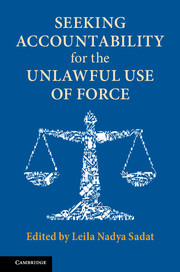Book contents
- Frontmatter
- Dedication
- Contents
- Notes on Contributors
- Foreword
- Preface
- Table of Cases
- Introduction
- PART I HISTORIC AND CONTEMPORARY PERSPECTIVES ON THE UNLAWFUL USE OF FORCE
- PART II MECHANISMS FOR RESTRAINING THE UNLAWFUL USE OF FORCE AND ENHANCING ACCOUNTABILITY
- 7 Commissions of Inquiry and the Jus ad Bellum
- 8 The International Court of Justice and the Use of Force
- 9 The Other Enemy: Transnational Terrorists, Armed Attacks, and Armed Conflicts
- 10 Toward the Substantive Convergence of International Human Rights Law and the Laws of Armed Conflict: The Case of Hassan v. the United Kingdom
- 11 International Law on the Use of Force: Current Challenges
- PART III THE ILLEGAL USE OF FORCE AND THE PROSECUTION OF INTERNATIONAL CRIMES
- PART IV IMAGINING A BETTER WORLD
- Epilogue
- Index
8 - The International Court of Justice and the Use of Force
from PART II - MECHANISMS FOR RESTRAINING THE UNLAWFUL USE OF FORCE AND ENHANCING ACCOUNTABILITY
Published online by Cambridge University Press: 21 May 2018
- Frontmatter
- Dedication
- Contents
- Notes on Contributors
- Foreword
- Preface
- Table of Cases
- Introduction
- PART I HISTORIC AND CONTEMPORARY PERSPECTIVES ON THE UNLAWFUL USE OF FORCE
- PART II MECHANISMS FOR RESTRAINING THE UNLAWFUL USE OF FORCE AND ENHANCING ACCOUNTABILITY
- 7 Commissions of Inquiry and the Jus ad Bellum
- 8 The International Court of Justice and the Use of Force
- 9 The Other Enemy: Transnational Terrorists, Armed Attacks, and Armed Conflicts
- 10 Toward the Substantive Convergence of International Human Rights Law and the Laws of Armed Conflict: The Case of Hassan v. the United Kingdom
- 11 International Law on the Use of Force: Current Challenges
- PART III THE ILLEGAL USE OF FORCE AND THE PROSECUTION OF INTERNATIONAL CRIMES
- PART IV IMAGINING A BETTER WORLD
- Epilogue
- Index
Summary
INTRODUCTION
The International Court of Justice (ICJ) began operation in 1946 as the primary judicial organ of the United Nations. It is one of the six principal organs of the United Nations organization, the post-war manifestation of the alliance against fascism and our principal attempt to repair the failings of the earlier League of Nations. Consequently, one might expect the Court to have a role in matters of international peace and security, which are among the United Nations’ chief concerns. The Court has performed this role by hearing the cases brought before it and handing down judgments thereon. This Chapter reviews this history and the contribution of the Court in relation to the use of force.
This Chapter will first examine the jurisdictional barriers to the Court's consideration of cases involving the use of force. These are often considerable and have on multiple occasions frustrated States seeking redress for the unlawful use of force. Second, the Chapter will turn to the doctrinal contributions of the Court's jurisprudence on the use of force. Significant among these have been the Court's role in interpreting the U.N. Charter and determining the content of customary international law. Third, the Chapter will consider how the Court has used the principle of non-use of force as an interpretive principle to determine the scope of application of other international legal norms. Fourth, the Chapter will consider the Court's role in providing alternatives to force through the judicial resolution of disputes. Finally, this Chapter will consider what the future likely holds for the Court and its jurisprudence.
In order to accomplish this, some questions will be excluded. For example, the Permanent Court of International Justice is outside the scope of this Chapter for two reasons. First, the Permanent Court heard no cases concerning the use of force. Although international law did regulate the use of force in the first half of the twentieth century, through classical jus ad bellum and modern conventions, the Permanent Court was never seized of a case concerning the topic. Second, the law on the use of force has changed since the Permanent Court was replaced in 1946. Superseded by the U.N. Charter, older conventions and custom have lost their relevance. Indeed, as will be discussed, custom has since evolved to mirror the Charter.
- Type
- Chapter
- Information
- Seeking Accountability for the Unlawful Use of Force , pp. 194 - 218Publisher: Cambridge University PressPrint publication year: 2018

